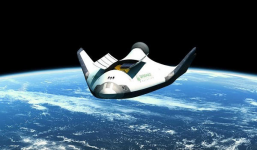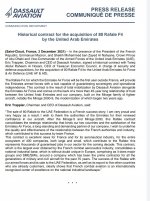La Direction générale de l’armement discute d’un projet d’avion « spatial » avec Dassault Aviation
The Directorate General of Armaments is discussing a "space" aircraft project with Dassault AviationBY LAURENT LAGNEAU - 24 NOVEMBER 2021
In October 2019, General Philippe Lavigne, then Chief of Staff of the French Air & Space Force [AAE], estimated that the question of a "space drone", like the American X-37B, capable of remaining in orbit for several hundred days, would "certainly" end up being "addressed one day". And it was by the deputies Jean-Louis Thériot and Benjamin Grivaux, in their report on the consequences of the "covid" crisis on the Defence Technological and Industrial Base [DTIB], published a few months later.
Indeed, the two parliamentarians reported that, among its priorities, the new Space Command [CoE] was considering an "X-37B-type space shuttle, a segment in which Dassault has developed a Space Rider and Airbus a Space Tug". He suggested that such a project could benefit from the government's economic recovery plan, which was then being drawn up. In the end, this did not happen...
In Germany, however, the idea of developing a 'space drone' did gain ground. And last July, the young company Polaris Raumflugzeuge, created in the wake of the Centre for Aeronautics and Astronautics [Deutsches Zentrum für Luft- und Raumfahrt, or DLR], obtained a - modest - 250,000-euro contract from the German Ministry of Defence to study the possible military applications of its 'Aurora' spaceplane, within the framework of its RDRS [Rapid Deployable Reconnaissance System] programme.
However, as Mr Thiérot and Mr Grivaux pointed out, there is no lack of ambition on the French side. Notably at Dassault Aviation, whose CEO, Éric Trappier, has been defending the development of a "space plane" for some time. Moreover, the manufacturer is studying reusable space transport to launch satellites into low orbit, via the VEHRA project [Airborne Reusable Hypersonic Vehicle].
"Whoever controls space will control what is below. We will have to be in space with space planes in 15 to 20 years' time," he said in November 2018 before the Centraliens association. "If we manoeuvre in space, Dassault has a brick through its skills to bring to any prime contractor," he added.
More recently, in an interview given to the daily Les Echos, Mr. Trappier had put this subject back on the table. "What makes a fighter plane strong is its ability to detect and fire first. This implies being as discreet as possible and seeing further than the adversary, particularly in the face of increasingly effective anti-aircraft defences. And all this in permanent connection with the different military components, as well as with the authorities, who must know what is happening before giving the order to fire. [...] But if we look ahead," he continued, "this presupposes a spatial ambition. And then, one day, we will have to think about a space plane," he said last February.
Will such a project become a reality? In any case, the Directorate General of Armaments [DGA] is discussing it with Dassault Aviation. This is what Emmanuel Chiva, the director of the Defence Innovation Agency [AID], told La Tribune when asked about this space plane project.
"We are discussing with Dassault Aviation and the DGA, in particular the SASD [Defence Systems Architecture Department]. We also have projects with companies that we support. This is the case with Unseenlabs and Cailabs," Chiva replied.
The SASD [formerly the Future Systems Preparation and Architecture Service] is responsible for leading "DGA's actions in preparing for the future in technical and operational fields" and conducting "the preparation of armament operations".
Mr Chiva's reply suggests that the companies Cailabs and Unseenlabs would be involved in these discussions. Cailabs, a DeepTech company, owns a set of disruptive technologies that are the subject of 19 patent families. It has developed a technology that increases the performance of various defence applications [communications, LIDAR, etc.]. The second company specialises in the interception of radio frequency signals from space.











